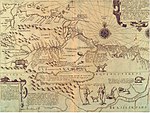Archivo:1656 Sanson Map of Guiana, Venezuela, and El Dorado - Geographicus - Guiane-sanson-1656.jpg

Tamaño de esta previsualización: 770 × 600 píxeles. Otras resoluciones: 308 × 240 píxeles · 617 × 480 píxeles · 986 × 768 píxeles · 1280 × 997 píxeles · 2560 × 1994 píxeles · 4000 × 3115 píxeles.
Ver la imagen en su resolución original (4000 × 3115 píxeles; tamaño de archivo: 3,32 MB; tipo MIME: image/jpeg)
Historial del archivo
Haz clic sobre una fecha y hora para ver el archivo tal como apareció en ese momento.
| Fecha y hora | Miniatura | Dimensiones | Usuario | Comentario | |
|---|---|---|---|---|---|
| actual | 23:46 23 mar 2011 |  | 4000 × 3115 (3,32 MB) | BotMultichillT | {{subst:User:Multichill/Geographicus |link=http://www.geographicus.com/P/AntiqueMap/Guiane-sanson-1656 |product_name=1656 Sanson Map of Guiana, Venezuela, and El Dorado |map_title=Partie de Terre Ferme ou sont Guiane et Caribane, augmentée et corrigée s |
Usos del archivo
No hay páginas que enlacen a este archivo.
Uso global del archivo
Las wikis siguientes utilizan este archivo:
- Uso en ar.wikipedia.org
- Uso en de.wikipedia.org
- Uso en en.wikipedia.org
- Uso en fr.wikipedia.org
- Uso en gcr.wikipedia.org
- Uso en hu.wikipedia.org
- Uso en it.wikipedia.org
- Uso en la.wikipedia.org
- Uso en ru.wikipedia.org
- Uso en uk.wikipedia.org
- Uso en www.wikidata.org

